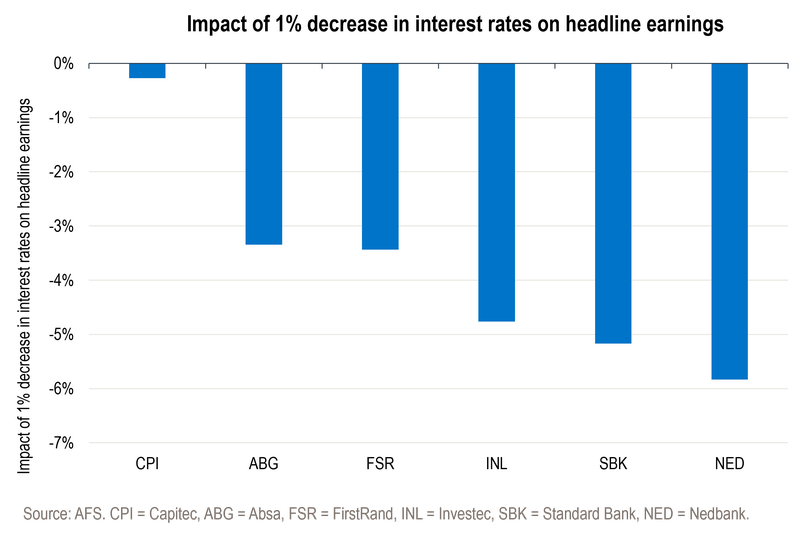Stay abreast of COVID-19 information and developments here
Provided by the South African National Department of Health
HOW DO FALLING RATES
AFFECT THE BANKING SECTOR?
As inflation reaches central bank targets and we transition into a period of easing interest rates globally, the effects are likely to ripple across economies and, in turn, impact investment markets. In South Africa, a reduction in interest rates will help alleviate pressure on consumers and stimulate economic growth. For banks and investors in the sector, however, a different set of challenges and opportunities arise. What does a falling rate environment mean for our banking sector, and where might investors find growth and stability?
South Africa’s banking industry is led by major players Standard Bank, FNB, Nedbank, Absa, Capitec and Investec – the first four accounting for 90% of South African loans and deposits. These banks, known for their conservative approach, have demonstrated resilient earnings and maintained strong capital positions – their reputation solidified by their ability to withstand multiple financial crises such as the Covid-19 pandemic.
However, they’re not immune to the macro environment, including the effects of changing interest rates. Since 2020, we have witnessed these businesses enjoy a stellar recovery, exceeding their 2019 earnings bases. Among the drivers of this recovery were the benefit of rising interest rates and the positive endowment effect. However, along with this tailwind for earnings came the negative impact of increased defaults by borrowers.
South Africans have experienced rising interest rates over the past few years, with most observers of the view that we’re currently at the top of the rate cycle. With inflation starting to come under control, the South African Reserve Bank has begun to slowly shift gears. This pivot towards lower rates encourages borrowing and increased spending, giving businesses room to invest and expand. But what does it mean for banks – and crucially, for those invested in them?
While rate cuts can boost economic activity, they also squeeze margins, influencing profitability and how banks grow their loan books. The relationship between falling rates and bank profitability is complex.
An immediate impact of lower interest rates on banks is a squeeze on their net interest margins (NIMs) – the difference between what they earn on loans and what they pay on deposits. In a falling rate environment, the rates banks charge on loans drop since many are variable-rate, prime-linked loans rather than fixed-rate loans. While deposit rates are also expected to drop, we believe that the current environment is highly competitive as banks compete for customer deposits and loans, which will see NIMs narrow and impact profitability.
The graph below provides a simple illustration of the sensitivity of earnings due to declining rates:

As can be seen on the graph, a reduction in interest rates affects each bank individually. According to our calculations, Nedbank’s earnings are the most sensitive to a 1% reduction in interest rates, resulting in a 6% decline. This sensitivity can be attributed in part to its business composition and current lack of an interest rate hedging strategy, unlike Absa and FirstRand. Consequently, during the period of rising interest rates, Nedbank’s margins expanded, offsetting the impact of credit losses and supporting robust earnings growth.
In contrast, Absa implements an interest rate hedging strategy aimed at maintaining stable margins across different interest rate cycles. While this approach has limited the benefits to Absa during rate hikes, it does mean the bank faces less earnings pressure as interest rates decline. Similarly, FirstRand shows lower sensitivity to interest rate fluctuations, reflecting a comparable stability in earnings under shifting macroeconomic conditions.
While Standard Bank has recently implemented a hedging strategy for its South African loan book, which has reduced its sensitivity over the past 12 months, a large portion of the bank’s business is from the rest of Africa, which is not hedged.
Investec has no hedging strategy in place for either its local or its UK business. While we’re illustrating the headwind on earnings for a 1% reduction in rates, it must be noted that 50% of Investec’s earnings and loan book are from the UK. If the UK starts to normalise interest rates, it could reduce rates by much more than 1%, posing an even greater risk.
On the upside, lower rates often stimulate demand for loans, especially in the home loans and consumer lending segments. Lower borrowing costs make debt more attractive for individuals and businesses. They also enhance credit affordability, thus supporting banks in expanding their loan portfolios. This increased lending activity can offset some of the NIM compression, particularly for banks with strong retail portfolios, which can benefit from a lending and transactional banking perspective.
In addition, debt servicing becomes easier as interest rates fall, and the risk of default generally decreases. This means banks may not need to set aside as much in provisions for bad loans, which can improve profitability. For investors, this can signal a more stable income outlook from banks as the risk of credit losses falls, potentially improving earnings visibility.
Stable margins and improved credit losses are particularly relevant for Absa at the moment. The bank is poised to benefit from lower rates, but it can show better earnings growth than peers as its credit losses unwind from elevated levels over the next 12 months, especially within its large retail business.
FirstRand is well positioned to navigate shifts in the interest rate environment. Its high-quality loan portfolio, proven capacity for deposit growth and robust retail business make it well equipped to capitalise on an improving consumer landscape in South Africa. Additionally, FirstRand’s ongoing focus on revenue diversification through cross-selling, insurance, and wealth and investment services further strengthens its strategic outlook.
The prospect of falling interest rates is shifting the landscape for South African banks. By keeping an eye on which banks are best positioned to leverage a lower-rate environment, investors can make more informed decisions, balancing short-term challenges in the industry with long-term growth potential.
Sanlam Private Wealth manages a comprehensive range of multi-asset (balanced) and equity portfolios across different risk categories.
Our team of world-class professionals can design a personalised offshore investment strategy to help diversify your portfolio.
Our customised Shariah portfolios combine our investment expertise with the wisdom of an independent Shariah board comprising senior Ulama.
We collaborate with third-party providers to offer collective investments, private equity, hedge funds and structured products.
Your wealth plan is designed with you in mind. Your financial reality, aspirations and risk profile.
Carl Schoeman has spent 22 years in Investment Management.

Have a question for Carl?
South Africa
South Africa Home Sanlam Investments Sanlam Private Wealth Glacier by Sanlam Sanlam BlueStarRest of Africa
Sanlam Namibia Sanlam Mozambique Sanlam Tanzania Sanlam Uganda Sanlam Swaziland Sanlam Kenya Sanlam Zambia Sanlam Private Wealth MauritiusGlobal
Global Investment SolutionsCopyright 2019 | All Rights Reserved by Sanlam Private Wealth | Terms of Use | Privacy Policy | Financial Advisory and Intermediary Services Act (FAIS) | Principles and Practices of Financial Management (PPFM). | Promotion of Access to Information Act (PAIA) | Conflicts of Interest Policy | Privacy Statement
Sanlam Private Wealth (Pty) Ltd, registration number 2000/023234/07, is a licensed Financial Services Provider (FSP 37473), a registered Credit Provider (NCRCP1867) and a member of the Johannesburg Stock Exchange (‘SPW’).
MANDATORY DISCLOSURE
All reasonable steps have been taken to ensure that the information on this website is accurate. The information does not constitute financial advice as contemplated in terms of FAIS. Professional financial advice should always be sought before making an investment decision.
INVESTMENT PORTFOLIOS
Participation in Sanlam Private Wealth Portfolios is a medium to long-term investment. The value of portfolios is subject to fluctuation and past performance is not a guide to future performance. Calculations are based on a lump sum investment with gross income reinvested on the ex-dividend date. The net of fee calculation assumes a 1.15% annual management charge and total trading costs of 1% (both inclusive of VAT) on the actual portfolio turnover. Actual investment performance will differ based on the fees applicable, the actual investment date and the date of reinvestment of income. A schedule of fees and maximum commissions is available upon request.
COLLECTIVE INVESTMENT SCHEMES
The Sanlam Group is a full member of the Association for Savings and Investment SA. Collective investment schemes are generally medium to long-term investments. Past performance is not a guide to future performance, and the value of investments / units / unit trusts may go down as well as up. A schedule of fees and charges and maximum commissions is available on request from the manager, Sanlam Collective Investments (RF) Pty Ltd, a registered and approved manager in collective investment schemes in securities (‘Manager’).
Collective investments are traded at ruling prices and can engage in borrowing and scrip lending. The manager does not provide any guarantee either with respect to the capital or the return of a portfolio. Collective investments are calculated on a net asset value basis, which is the total market value of all assets in a portfolio including any income accruals and less any deductible expenses such as audit fees, brokerage and service fees. Actual investment performance of a portfolio and an investor will differ depending on the initial fees applicable, the actual investment date, date of reinvestment of income and dividend withholding tax. Forward pricing is used.
The performance of portfolios depend on the underlying assets and variable market factors. Performance is based on NAV to NAV calculations with income reinvestments done on the ex-dividend date. Portfolios may invest in other unit trusts which levy their own fees and may result is a higher fee structure for Sanlam Private Wealth’s portfolios.
All portfolio options presented are approved collective investment schemes in terms of Collective Investment Schemes Control Act, No. 45 of 2002. Funds may from time to time invest in foreign countries and may have risks regarding liquidity, the repatriation of funds, political and macroeconomic situations, foreign exchange, tax, settlement, and the availability of information. The manager may close any portfolio to new investors in order to ensure efficient management according to applicable mandates.
The management of portfolios may be outsourced to financial services providers authorised in terms of FAIS.
TREATING CUSTOMERS FAIRLY (TCF)
As a business, Sanlam Private Wealth is committed to the principles of TCF, practicing a specific business philosophy that is based on client-centricity and treating customers fairly. Clients can be confident that TCF is central to what Sanlam Private Wealth does and can be reassured that Sanlam Private Wealth has a holistic wealth management product offering that is tailored to clients’ needs, and service that is of a professional standard.